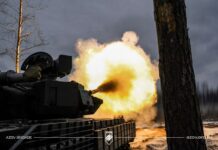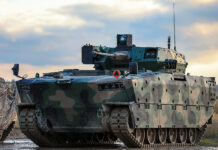With weapon lethality at an all-time high, and many confirmed losses of modern land vehicle platforms across multiple battlefields, it is worth examining the extent to which current protection systems are up to facing the challenges of the modern battlefield.
In order to analyse the efficacy of modern armour on current battlefields, an analytical framework has been established. The goal of the framework is to provide a single set of criteria against which multiple case studies can be compared. The framework considers the following elements in combination:
- The modern survivability matrix: This variable provides a technical description of the dominant survivability matrix for each case study.
- Combat scenario: This variable provides context and will attempt to describe the predominant operating conditions of the case study.
- The threat: Analysis of the threat will seek to understand how the opposing side has sought to counter the survivability matrix in question.
- Mission success: Analysis of mission success and the ability of the survivability matrix to contribute to it will be based upon the perceived ability of the force in question to operate tactically and any resultant losses.
- The final element of the framework will consider the above to assess how effective the survivability matrix in question was within the defined scenario.
This analysis will draw on three case studies from modern warfare and the data used will be a mixture of quantitative and qualitative, drawing on vehicle and personnel losses where reliable and consistent figures can be found. This will be combined with a technical understanding of modern armour and anti-armour weapons.
The ‘modern’ survivability matrix
Modern vehicle armour is part of a survivability matrix, this means that all elements of a vehicle’s survivability are connected and affect the way that armour has developed – it is not sufficient to simply look at the physical armour. The matrix consists of the vehicle, the armour that protects it, and any active protection systems it carries. This analysis also considers mission systems fitted to the vehicle, and its perceived accuracy and lethality. This is because a vehicle’s survivability is not just decided by its ability to withstand a hit from an anti-tank guided missile (ATGM). It is partly decided by its ability to successfully enact its user’s will onto an opponent and inflict losses in return for any engagement, whether successful or not.

Credit: Ukrainian MoD
In most cases, modern survivability matrices have been developed and deployed onto legacy platforms. The Merkava Mk IV, for example, builds upon the foundation of the Merkava Mk I that entered service in 1979.[1] The Leclerc used by the UAE in Yemen was designed following studies initiated in 1972 and an initial concept proposed in 1982.[2] This has had ramifications for almost every heavy AFV that is currently in operation and considered below. Most designers anticipated that the front 60° arc would need the greatest protection, leading to disproportionate weighting to the frontal arc. Consider this against the case studies below, every conflict has at some point involved urban warfare and 360° threat vectors leading to vehicle losses. It is likely that designers would take a different approach to survivability if starting from a clean sheet. It stands to reason that the ‘modern armour’ considered here is in some way operating at an inherent disadvantage compared to threats that have developed free of any Cold War-imposed constraints.
So, whilst the survivability matrices considered here represent the leading edge of modern armour, they are in fact products of the Cold War that have been modified to carry cutting edge survivability solutions. There are, of course, more modern designs; the South Korean K2 and Japan’s Type 10 are notable MBTs that have been developed inside the 21st century, but neither has been deployed operationally, making an analysis of their survivability matrix based upon combat experience impossible. It would, however, be possible to apply the theory of this analytical framework to them at a later date. In short, ‘modern armour’ is also working by and large within the constraints of perceptions of warfare in the 1980s, which means that adaptations to modern threats have been applied to existing designs, rather than built into the vehicles in question, which would be optimal.
Case study: Ukraine’s counter-offensive, 2023
Context
Ukraine’s counter-offensive in 2023 was understood to have been intended to reach the city of Melitopol, with a stretch goal of pushing through Russian forces to the coast. The Russian forces had spent a considerable length of time preparing their positions to absorb and counter the offensive. They did so broadly according to their doctrine and an understanding of defensive operations that can be traced to the 1980s. The Ukrainians had received training from Western partners and it is now broadly understood that this failed to account for the conditions in Ukraine as well as the ability to conduct the large-scale (i.e., brigade-level) combat that would have been necessary for Ukraine to succeed, or achieve more than it did. The offensive had multiple aspects to it, but this article will primarily consider the use of NATO armour such as the Leopard 2, Bradley, and CV90 series vehicles.

Credit: Ukrainian MoD
Adversary armament and tactics
Russian defensive doctrine is composed of interconnected strongpoints that are fortified with trenches and obstacles. They do not form a continuous line, but the gaps between them are covered by indirect fires. A screening line of troops using anti-tank guided missiles (ATGMs) is expected to provide an initial blunting effect that forces the attacker to stack up, or deploy into an attacking formation early, thereby slowing the advance and providing a target for artillery and aviation. The majority of the defence is conducted by infantry with support from armoured fighting vehicles where appropriate. For example, Russian tanks were deployed in small squadrons of 2-3 vehicles to engage Ukrainian formations that had been slowed or immobilised by the screening force and minefields, often resulting in heavy losses on both sides.
Russia is by far the most capable adversary considered within this analysis and therefore the greatest test of modern armour. Its units deployed an array of equipment summarised in Table 1 below. Anecdotal accounts indicate that even during the largely successful Ukrainian offensive around Kharkov, Russian units were adept at forcing Ukrainian formations to stack up. When this occurred, Ka-52 helicopters would engage slowed or immobilised units using ATGMs. This tactic was repeated during Ukraine’s counter-offensive. Other tactics include the use of massed MRL fire from the BM-30 Smerch and BM-21 Grad to saturate Ukrainian units with cluster munitions and re-sow minefields that had been partially cleared. Further conversations with Ukrainian soldiers indicate that the Russian use of FAB-500 bombs with UMPK guidance kits has been devastating to some Ukrainian operations. This is combined with the use of loitering munitions such as the Lancet-3M and first-person view (FPV) drones, combined with conventional semi-active laser (SAL) guided artillery munitions.
| Table 1: A selection of weaponry employed by Russian troops in Ukraine | ||
| Name | Range | Penetration (RHAe) |
| 9M133M-2 Kornet | 8,000 m | 1,300 mm |
| 9M120M Ataka | 8,000 m | 950 mm |
| LMUR | 15 km | Unclear – 25 kg warhead |
| Lancet-3M | Up to 50 km | Unknown |
| FPVs | 1,000 m | 300 mm* |
| UMPK-equipped bombs | 60 – 80 km** | Significant wide-area blast damage |
| Notes:
*Assuming the FPV is fitted with a PG-7V type warhead. |
||
Furthermore, the Russians also built deeper minefields than expected, which created many challenges for Ukrainian units with scarce mine clearing resources, and trained to breach minefields according to Western doctrine.[3] This was coupled with a very high density of mines and IEDs, as well as the practice of stacking anti-tank mines on top of each other to guarantee an immobilised vehicle. It is important to emphasise that Russian defences are centred around firepower and coordination between the motorised/mechanised rifle battalions, artillery, and aviation. The net result is a plethora of weapons that are brought together in a single battlespace with a high hit probability and considerable lethality. The challenge for Ukrainian units was always going to be immense and fraught with risk.
Ukrainian armour and tactics
Ukraine deployed a broad range of armoured vehicles during the offensive including Leopard 2s in various configurations up to the very capable Leopard 2A6, M2 Bradleys and CV90s, as well as Challenger 2s. They were accompanied at times by MaxxPro MRAPs and Soviet BMPs as well as some T-72s and T-64s. The Western platforms essentially represent the most survivable systems in service with Ukraine, and those that were most likely to be heavily used during the counter offensive.
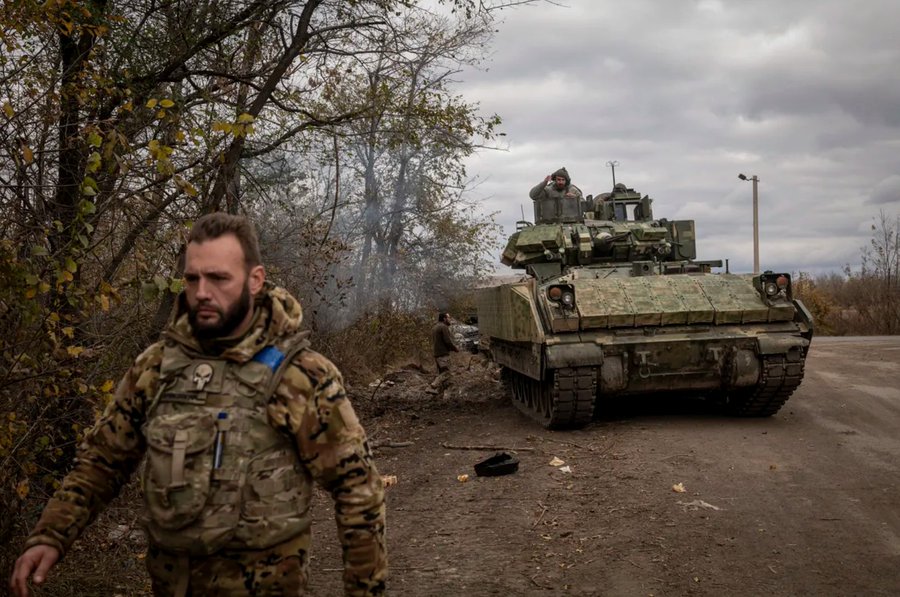
Credit: Ukrainian MoD
The tactics used included preparatory artillery bombardments and the use of drones to provide overwatch and targeting of Russian troops and vehicles. Ukraine also deployed FPVs, however their impact on heavily protected vehicles is mixed at best, and may even be minimal insofar as catastrophic kills are concerned. The far greater impact of small drones was in their use to direct and correct artillery fire on Russian positions. The overall goal of Ukrainian tactics appears to have been driving Russian troops from their forward trenches, then taking and holding these positions, and then defending against a Russian counterattack to retake the positions. In some places, the Russian defence was overly forward leaning when compared with its doctrine; a lot of effort was spent engaging Ukrainian advances as far forward as possible, as opposed to meeting them from within the protection afforded by the fortifications prepared in advance.
Losses
Assessing Ukraine’s total losses in the counter-offensive is difficult. The New York Times reported that 20% of Ukraine’s equipment had been destroyed in July, citing US officials.[4] The personnel losses are also thought to have been high. In terms of western equipment, the pro-Russian source lostarmour has documented 16 Leopard 2s either damaged or destroyed. The evidence attached to those claims indicates that at least five continued burning at a low level after being hit. The same site has documented 41 immobilised or destroyed Bradleys, 13 Strykers, and 2 CV90s.[5]
An indication of the survivability of western armour is provided by a report titled Putting Medical Boots on the Ground, which was published in August 2023 by the Global Surgical and Medical Support Group (GSMSG).[6] The group’s representatives in Ukraine examined the effects of the Kornet ATGM and were told that against light and lightly armoured vehicles such as the Humvee, BRDM, and M113, it often had devastating results. “If the jet hit an unlucky individual they were generally vapourised. Other occupants of the vehicle were usually “blown apart” so it was likely a combination of spalling and fragmentation shredding the occupants as well as the blast wave literally tearing people apart. In addition, there was barotrauma to the brains and lungs of anyone who survived the other effects,” a GSMSG representative told ESD via email.
The report notes that such attacks against this category of vehicles exhibited a greater than 75% fatality rate. In contrast, when the same missile hit a heavily armoured vehicle such as a Leopard 2 or Bradley, most crews reportedly survived. However, there were some examples of catastrophic impacts that immediately destroyed the vehicle, the representative said. This supports other claims that Western armour was very survivable in the event of an ATGM strike, and lends credence to the assessment that modern survivability matrices are sufficient for the current threat landscape.
This outcome was not limited to Western platforms; a RUSI report on Ukraine’s counter-offensive indicates that gun-launched ATGMs fired against Russian tanks with Kontakt-5 explosive reactive armour (ERA) such as the T-72B3M often failed to defeat the vehicle, even with multiple hits.[7] However, the efficacy of a lot of Russian and Soviet armour is undermined by design decisions around ammunition stowage. Every Soviet and Russian-designed tank after the T-55 employs a carousel autoloader in the centre of the vehicle carrying its ammunition, which tends to detonate when hit by an ATGM or APFSDS. By contrast, Western vehicles favour more protected magazines with ammunition either separated from the crew by armoured blast doors and blow-out panels fitted above the ammunition stowage. In Soviet tank designs, the turret crew is seated on top of the magazine, separated by a thin sheet of steel. Consequently, the turret can be separated from the vehicle by a magazine detonation. So, whilst the vehicles might be sufficiently protected to withstand multiple strikes, the post-penetrative effects will likely be a lot worse for the crews of Soviet and Russian-designed vehicles.

Credit: Russian MoD
Assessment
Ukraine has failed to achieve the aims of its counter-offensive. It has reclaimed marginal amounts of territory from Russian occupation, but the strategic situation remained largely unchanged at the time of writing in late-November 2023. The Russians certainly suffered attrition, that is clear. However, the relatively small quantities of western armour and artillery supplied to Ukraine were unlikely to ever dismantle Russia’s layered fires network and established defensive lines. From the density of the minefields to difficulties in massing fires in preparation of an attack, and the inability to conduct brigade-level operations, there is little that the added survivability of Western armour could add to the probability of success.
Within reason, Western armour was adequately suited to the lethality it faced during Ukraine’s counter-offensive, but that was never going to be the deciding factor. A brief analysis of the 1991 Gulf War provides an indication of what might have been required to succeed. By February 1991, the Coalition forces had conducted a 6-week aerial campaign that targeted the infrastructure and command networks of the Iraqi forces. In the hours preceding the ground operation they conducted an enormous artillery barrage with hundreds of guns and rocket launchers. Thousands of shells and rockets were fired, many of them were cluster munitions and the intensity of the barrage was such that one participant recalled the ground shaking as he waited to advance. The subsequent advance met with resistance, but it also met thousands of Iraqis ready to surrender and defensive positions that were no longer effective. One Iraqi commander reportedly told his captors that of 100 guns in his division, 83 were destroyed by this targeted artillery barrage.[8] There are undoubtedly multiple causes behind the Coalition’s rapid success, but the massed firepower cannot be dismissed as a cardinal contributor.
So, what can be said of modern armour based upon Ukraine’s experience? It is clear that when heavily armoured vehicles – Bradley, Leopard 2, CV90 etc – were engaged, the crew and dismounts had a reasonably good chance of surviving. The comparison with light vehicles is stark, as indicated by the GSMSG report cited above. It is also apparent that Russian armour, often protected by Kontakt-5 or Relikt ERA, was resistant to some of the more potent weapons deployed on the battlefield, thereby extending its ability to operate and inflict damage on Ukrainian troops. However, it also shows that the survivability matrices of Western platforms are not a panacea and do not guarantee success, despite their qualities when compared with Soviet-era platforms. Ukraine was unable to deploy sufficient firepower to blunt and defeat Russia’s massed artillery assets, anti-armour helicopter sorties, and ATGM teams. As a result of this, its units became extremely vulnerable once immobilised in minefields they were not equipped or trained to breach. Russian aviation had to consider the possibility of Ukrainian air defences, which shaped how close they could get to the front line, but this did not prove decisive.
The bottom line is that modern armour is dependent upon effective combined arms cooperation and the use of sufficient, sustained firepower to achieve its objectives. It is unlikely to succeed when deployed in isolation against a determined and well-equipped opponent without these aspects in place. This point is axiomatic for anyone who has studied warfare since 1939, however, it is worth emphasising. The protection of a modern armoured platform is only as good as the system within which it operates. Modern lethality, which is essentially typified in all three case studies by Kornet, is considerable and likely sufficient to defeat almost any vehicle eventually. Where losses need to be reduced to a minimum, care around combining arms and concentrating firepower is critical. The remaining case studies will demonstrate this in different contexts.
Case study: Israel’s offensive to isolate Gaza city, 2023
Context
Israel’s deployment to Gaza following the atrocities of Hamas’ 7 October 2023 attack came after close to a month of preparation. The quantity of troops dedicated to operations in Gaza is not clear, however, the Financial Times claimed that “35 battalions and four divisions” had been prepared as part of the “infrastructure” for a ground operation.[9] The opening phases of the IDF’s operation involved moving from the border with Gaza through fairly open terrain, into gradually more urban surroundings. The first thrust appears to have cut across the strip creating a corridor from the border to the sea; additional operations have been launched around the edges of Gaza City.[10] The stated goal is the complete removal of Hamas and its military capabilities, as well as replacement of its political elements with an alternative entity to manage the Gaza Strip.[11] At the time of writing in late-November, fighting was ongoing. For that reason, this section will not examine the overall success of the Israeli operation and look instead at select examples to illustrate the efficacy of Israeli armour.

Credit: IDF
Adversary armament and tactics
Hamas’ military wing, al-Qassam, is variously attributed with a combat strength of as many as 30,000 personnel. Hamas forces are divided into offensive and defensive roles. The former is charged with maintaining rocket launches against Israel and will not be covered here. The latter is designed to either prevent or defend against Israeli ground incursions. They are arranged into five regional brigades and 140 companies, according to the IDF.[12] The companies are understood to be further organised into platoons that are made up of three combat teams, which are the standard operating unit. The combat team is centred around an anti-armour capability that is typically, or ideally, supported by a sniper, medic, and a handful of fighters.[13] This pattern appears to have been maintained in 2023, with the frequent addition of a cameraman to film engagements.[14]
Armament includes the standard RPGs, assault rifles, some modern ATGMs and a greater number of older designs such as 9M14 Malyutka and 9M113 Konkurs, and some fighters are capable at deploying improvised explosive devices (IEDs) as part of their defensive lay down. The organisation was already capable of building and deploying shaped-charge type IEDs with various degrees of complexity in 2006, it should be assumed that the trend has continued. Hamas also has developed and manufactured the Yasin 105 tandem charge rocket, which is very often seen in videos of Hamas engaging IDF forces. The Yasin 105 bears very many similarities to the PG-7R tandem HEAT rocket that was introduced into service in 1988.[15] It includes a 64 mm precursor charge positioned ahead of a 105 mm main charge. Hamas claims the rocket can penetrate up to 750 mm of steel armour that is not protected by ERA.[16] Given the similarities to the PG-7R, it seems unlikely that the Yasin 105 was developed autonomously. Yasin 105 is not the most lethal weapon available to Hamas, which also has access to the 9M133 Kornet or its Iranian clone the ‘Delaviyeh’, supplied by Hezbollah.[17] Details of some of the weapons available to Hamas are provided in Table 2. Note that a key difference between table 1 and 2 is the delivery method; a Russian Ka-52 is generally much more mobile and survivable than a Hamas anti-tank platoon. Especially when operating as part of a combined arms unit.
| Table 2: An overview of the more potent anti-armour weapons available to Hamas. | ||
| Name | Range | Penetration (RHA equivalent) |
| Yasin 105 | 150 m | 750 mm without ERA, 600 mm with ERA. |
| 9M14P1 Malyutka-P1 | 3,000 m | 520 mm |
| 9M113M Konkurs-M | 4,000 m | 800 mm |
| 9M133-1 Kornet/Delaviyeh | 5,500 m | 1,200 mm |
| SPG9 | 800 m (direct fire) | 400 mm |
| IEDs | 5-10 m | Depending on size and quality of explosives/shaped charge |
| Note: the penetration statistics do not always correlate with behind-armour effects and subsequent lethality. | ||
Assessments in 2007 posited that Hamas would attempt to avoid fighting the IDF in the open and increase its level of resistance the deeper into urban territory that the IDF moved. It would combine IEDs with human shield tactics and suicide bombers to weaken the IDF and cause excessive casualties compared with the goal. The aim was to present an image of having defeated the IDF or frustrated its military objectives at least.[18] It appears that this pattern was maintained in 2023 with initial engagements conducted in the more rural terrain outside of Gaza city, and the fighting then becoming heavily urban in focus as the Israeli forces gained ground. Observed tactics seem to include lightly armed teams using tunnels and terrain to emerge at close proximity to Israeli forces to conduct a brief engagement before retreating.[19] It is notable that these teams very rarely carry more than one shot for an RPG-7 type launcher, indicating that they are not expecting a prolonged firefight.
Other tactics reported by the IDF include Hamas fighters deliberately swarming or ‘hugging’ their positions to make the use of close air support and other heavy firepower difficult. This tactic has resulted in the well-circulated videos of Hamas fighters placing explosives onto Merkavas. There is a singular report of the Golani Brigade’s 13th battalion being engaged by a force of 30 Hamas fighters who used IEDs, ATGMs and drones in a coordinated attack in early November. The Hamas force suffered 20 casualties, according to a report in the Guardian.[20]
IDF armour and tactics
The IDF deploys what is arguably one of the most survivable AFV families in the world in the form of the Merkava MBT and its Namer heavy APC. The two vehicles layer composite and steel armours with the Trophy APS. It is also possible that they carry some form of reactive armour, Israeli company Rafael for example, has designed ERA that is designed to counter kinetic energy threats.[21] They also employ sophisticated digital battle management systems with a common communications architecture that has been implemented since 2012. Over time, this has evolved to enable the use of systems like Fireweaver, an AI-enabled sensor-to-shooter system that fuses the outputs of multiple sensors and shooters into a single network, allowing the commander to task effectors based on availability and suitability in real time.[22]

Credit: IDF
The IDF’s tactics in Gaza are led by armour and typically consists of armoured formations in company strength consisting of 2-3 Merkavas accompanied by a similar quantity of Namers and engineering assets in the form of the D9 armoured bulldozer.[23] Additional fire support is provided by indirect fires, naval gunfire, drones, and close air support. There is a growing reliance on tactical precision assets such as the Spike guided missile and the 120 mm Iron Sting mortar round that has been used for the first time in Gaza.[24] Nevertheless, IDF tactics are best described as firepower heavy, and most movements are dominated by the Merkavas. One IDF soldier recalled, “Face-to-face fights are rare. We don’t see too many of them in person. Tanks will fire into buildings, and we will go to clear them. Usually the tanks get them.”[25]
The Merkavas provide a very important function for the IDF. For example, in the recovery of a battle-damaged vehicle they form a protective ring and use their firepower to enable recovery efforts.[26] The vehicles are – at this stage in their service life – essentially designed to assume stationary positions in urban environments and provide fire support and suppression against hostile forces. They also act as cover behind which dismounted infantry operate and shelter when engaged.[27] The IDF goal in Gaza is to eliminate Hamas’ military capabilities whilst minimising its own personnel losses. This means that movement is conducted inside of vehicles as much as possible to prevent losses from sniper fire and IEDs. At times, it also appears that the D9 bulldozers are used to prepare large berms that Israeli armoured formations will occupy, which may be an attempt to deter vehicle borne IEDs as well as providing extra protection from attack.
Losses
Since the ground phase of the operation inside Gaza was started there had (at the time of writing) only been one confirmed loss of an IDF vehicle. This was reportedly a Namer, which was destroyed in the early stages of the operation leading to the loss of all 11 personnel onboard.[28] However, the IDF released an article providing some insight into battle damage and repair (BDAR) operations. It indicated that the majority of damaged vehicles were driven out of contact to a repair centre and returned to combat. Some needed to be recovered, and it stated that some were beyond repair – those vehicles were salvaged for usable spare parts.[29] The report provided no indication of numbers or types of damaged vehicles.
By late-November 2023, the IDF had reportedly suffered 66 fatalities – some of which were friendly fire – and an unknown quantity of wounded.[30] Some analysis indicates that a force can expect 3 – 5 wounded for every soldier killed in combat, which suggests total IDF casualties in the hundreds. The IDF has also stated that hundreds of Hamas operatives had been killed by Israeli forces.
Assessment
Despite multiple videos released by Hamas showing engagements at close quarters with Israeli armour, there is not good evidence to support heavy losses. Moreover, the IDF had successfully entered Gaza city and claimed to have eliminated more than 80 Hamas commanders in the process. Overall, there is scant evidence of Israeli armour losses.[31] The lone IDF report on BDAR indicates that vehicles were certainly damaged, some of them irreparably, but the losses were ultimately insufficient to prevent the IDF from achieving tactical success against Hamas and commencing efforts to dismantle its tunnel network.

Credit: IDF
The survivability matrix of Israel’s armour undoubtedly contributed to its success in the opening phases of the operation and low combat losses. In addition to this, a key element was the IDF’s liberal use of firepower and combined arms operations as a central tenet of its operations. So, whilst the armour is survivable, its survivability was enhanced by the protection and additional capabilities provided by air power, artillery, precision strike assets and regular intelligence updates. It stands to reason, especially when the assessments of Ukraine’s operation are considered, that effective combined arms doctrine is a critical component of modern armour survivability. One might argue that modern armour is not designed to be survivable without it.
Case study: The Gulf Coalition in Yemen, 2015 onwards
Context
The Gulf Coalition was a Saudi-led force that deployed to Yemen in 2015 to support deposed President Abdu Rabu Mansour Hadi in Yemen’s fight against the Houthi movement, which had attracted support from elements of Yemen’s army. There are two armoured elements within the operation that will be considered; advances and engagements inside Yemen that were often led by armoured battle groups from the UAE, and cross-border raids into Saudi Arabia, which resulted in the loss of Saudi tanks and armoured vehicles.
Houthi forces had overthrown President Saleh and were in the process of capturing Aden, a port city at the tip of Yemen. The Houthis had been joined by defectors from the Yemeni Army and were equipped with tanks and other armoured vehicles. An initial deployment of UAE special forces saved the city from Houthi advances by directing air strikes against the armoured assaults. By August 2015 the UAE and Saudis were able to deploy a battalion-sized element of Leclercs, “dozens of BMP-3Ms”, supported by 155 mm G6 howitzers and other fire support assets.[32] The UAE-led battlegroup, which included around 1,500 Yemeni fighters, conducted a number of operations to recapture towns such as al–Anad and the Labouza military base around 30 km to the north of Aden.
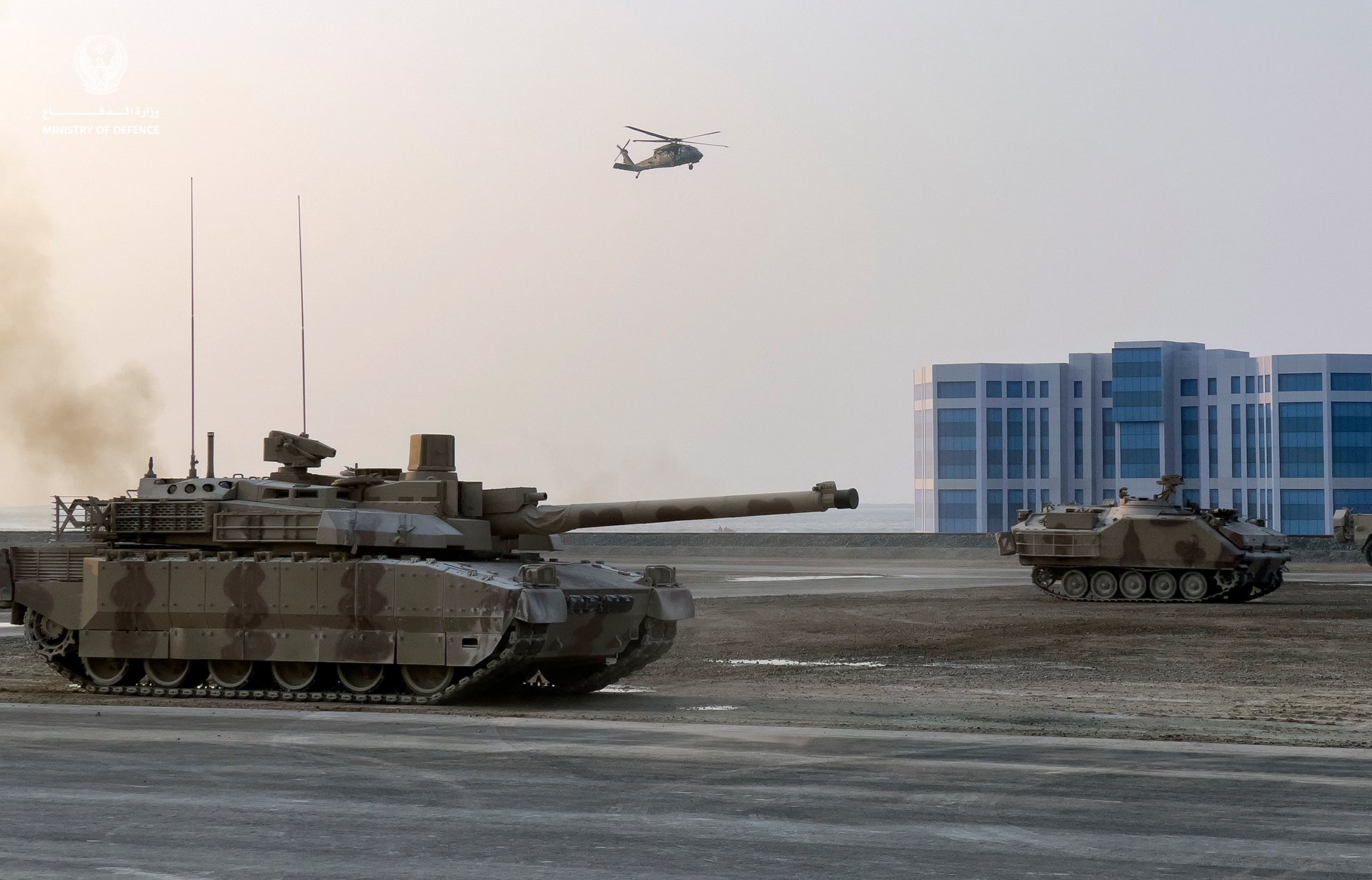
Credit: UAE MoD
Adversary armament and tactics
The Houthis were armed with anti-tank weapons provided by Iran such as the Delaviyeh/Kornet, Metis-M and RPG-29. The AM-50 anti-materiel rifle chambered in .50 BMG was also supplied by Iran. It is a single-shot rifle that has proliferated throughout the Middle East and is used by many of the forces that Iran supports.[33] The Houthis have also deployed mines and IEDs that range in complexity. At least one example in 2021 was fitted with a passive infrared sensor connected to a radio controlled arming sensor, which reflects the more advanced IEDs deployed against western forces in Iraq.[34] The Houthis also possessed armoured vehicles like T-55s and BMP-2s, but there is no clear evidence of them engaging Coalition forces.[35]
The Houthis developed an array of tactics to delay and attrit coalition forces. One of particular interest included a single fighter in networked fox holes, each armed with different types of weapon. The fighter would move between the fox holes using each weapon in turn, thereby convincing the coalition forces that they were facing a much larger force.[36] In addition, their tactics and techniques had been sharpened through a decade of war with the Yemeni armed force. They would prefer to use small groups of 3-5 fighters including at least one sniper, but would occasionally conduct set-piece battles to seize cities or larger objectives.[37] This is broadly in line with tactics used by other decentralised insurgent organisations such as the Taliban and ISIS. Furthermore, it is understood that the Houthis received training and support from Iran which led to the introduction of Delaviyeh/Kornet ATGMs in 2017, which were supposedly unavailable to the Houthis before then.[38] It is also notable that the 2015 portion of the operation at least, preceded the widespread use of small drones. In some sense, the coalition armour was saved from the effects of an additional challenging threat that has defined approaches to the Ukrainian and Israeli operations.
Analysis of earlier Houthi tactics from 2007 – 09 also indicates that they were capable of ambushing convoys, successfully attacking checkpoints and static forces, and small unit combat that could result in heavy casualties for both sides. They would also employ harassing fire using sniper rifles and mortars.[39]
Coalition armour and tactics
The UAE and Saudi forces continued their operations with two offensives; the Aden force continued operations towards the Bab el-Mandeb straits, where it advanced 160 km in two weeks. Another force including a UAE armoured battalion and mechanised elements from Saudi Arabia, Bahrain, Egypt and Qatar advanced on Marib in the east of Yemen. It advanced 50 km in two weeks, but struggled to reach Sana’a as it encountered strong resistance in the deserts and mountains approaching the city.[40]
The Leclerc and M1A2S were the MBTs of the UAE and Saudi forces respectively. The former combines advanced composite armours with steel and in some cases extensive suites of AZUR ERA and a soft-kill obscurant smoke-based active protection system. The Saudi M1A2S is protected with a combination of steel base armours and composite armour packs. However, its protection is focused on high risk areas – the turret cheeks and glacis – to a greater extent than an AZUR-equipped Leclerc. Therefore, ATGM engagements against the turret rear or side of an M1A2S often face much weaker defensive measures. The BMP-3 used by the UAE uses aluminium armour that is also concentrated on the frontal arc and designed for peer conflict with the US. Its critical flaw is the ammunition it carries for the 100 mm main gun, which is not built to high insensitive munitions standards. This means that a penetration of the armour and ammunition is likely to result in a catastrophic explosion. The Saudis also deployed the M2A2 Bradley IFV, which is built from aluminium armour with hardened steel plates as an add-on. It is capable of mounting ERA, but it is not clear whether this was ever done for Saudi vehicles.[41]
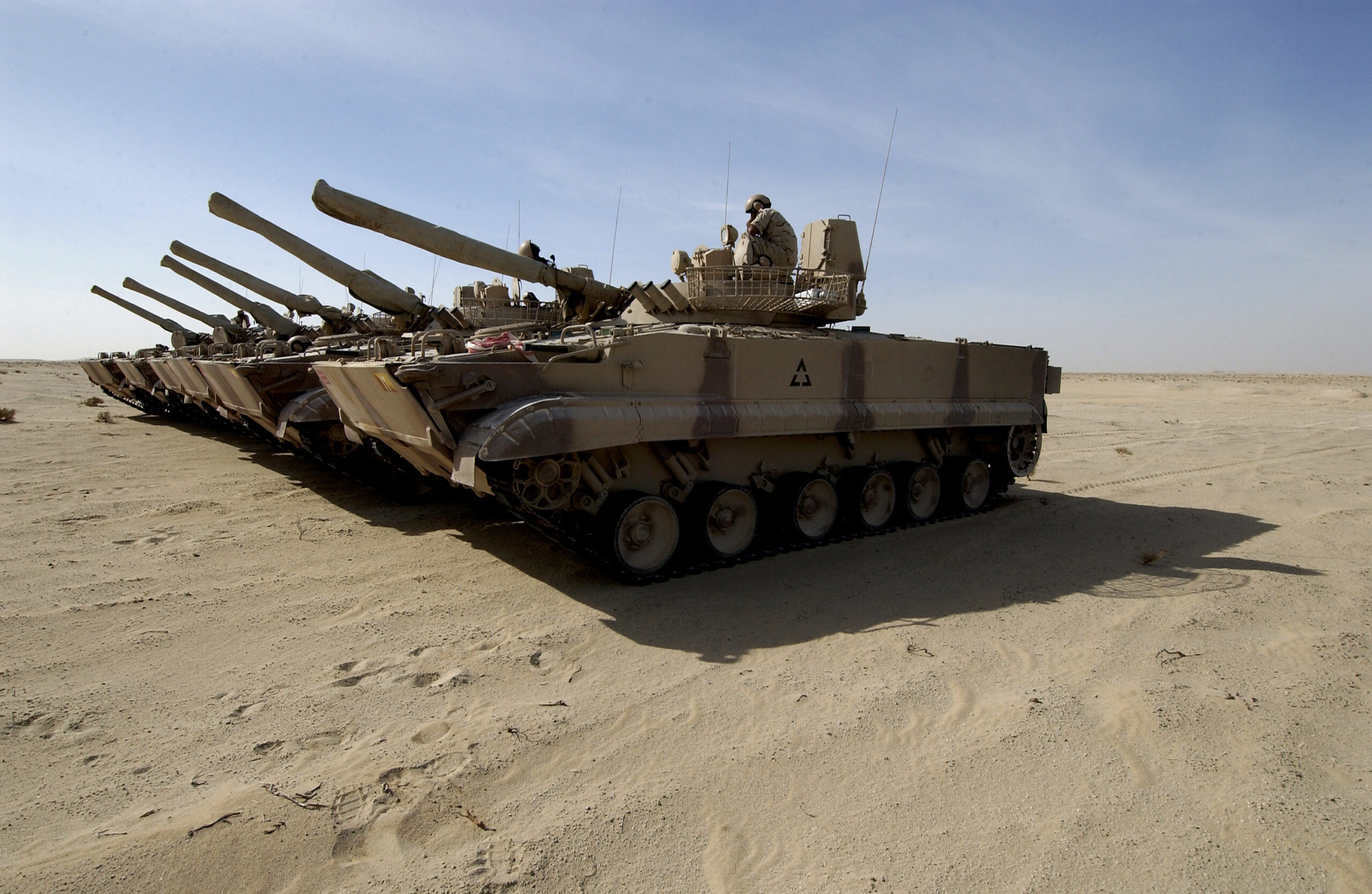
Credit: US Navy/Ted Banks
The total complement of Leclercs is believed to have reached 70 or 80 tanks that were deployed in squadrons of nine tanks for some operations.[42] They appear to have been used in a variety of roles from offensive dashes to secure strategic locations, defensive operations to hold them, and in direct support of infantry.[43] They operated alongside the BMP-3Ms and often in tandem with MRAP-type vehicles and M-ATVs.[44] UAE forces were able to successfully secure Aden and the al-Anad air base to the city’s north, the Leclerc played a leading offensive role in both operations.[45] They were supported by BMP-3s that were occasionally up-armoured with bar armour to increase protection against RPG-7s.[46]
Saudi forces were often embedded in stationary positions on the border with Yemen and also involved in patrols through Yemeni towns and countryside. Both forces supported their efforts with rotary and fixed wing aviation and were capable – at times – of good combined arms cooperation, although reports are mixed on this front and capabilities inevitably varied by unit.[47]
Losses
There are no definitive indications that any Leclercs were lost during these operations. One may have been penetrated by an ATGM, but the type is not known. If the report is accurate, the missile penetrated the frontal armour and killed the driver. The tanks are also thought to have survived IED and RPG strikes. However, there are several indications that the Houthis became adept at shooting the Leclerc’s prominent sight, external fittings and fume extractor using AM-50 anti-materiel rifles.[48] At least one BMP-3 was catastrophically destroyed, reportedly on the road between Aden and Abyan.[49]
The website Lostarmour indicates that 6 M1A2S tanks were destroyed in 2015, and the total reached 14 2021.[50] However, the available indications are that some were engaged whilst in stationary positions on the border with Yemen. The same site reports the loss of 36 Saudi M2A2 Bradley IFVs in 2015 and 59 in total by 2021.[51] The conditions of their loss vary, but some were engaged with an ATGM, an encounter that a Bradley is unlikely to survive. Some video footage from these engagements indicates a concerning trend for the tanks to cook-off over an extended period of time once hit. In one instance, this begins within five seconds of the missile striking the vehicle, which is unlikely to have allowed the crew time to escape.[52] Total Sudi losses may be as high as 3,000 personnel according to an article in The Independent from 2016, whereas the UAE had reportedly lost 108 personnel by 2020.[53]
Case study addendum: Iraqi losses facing ISIS
The Iraqi Security Forces (ISF) fought ISIS with a similar mix of equipment to the Saudi forces. Their MBT was the M1A1, a predecessor to the M1A2S and a mix of M113 APCs with more modern MRAPs and M1117s. The ISF suffered heavy losses from frequent ambushes and concentrated attacks against isolated and unsupported outposts.[54] In the battle of Mosul, its Abrams losses were so severe that the country’s President ordered the ISF to stop using them inside the city.[55] As is the case for the Saudi M1A2S, videos of ATGM engagements against Iraqi M1A1s indicate a tendency to cook-off very shortly after an engagement.[56] Whilst both vehicles store ammunition behind armoured blast doors and blow-out panels, the extent of the cook-off and resultant blaze would at least result in an effective mission-kill of the vehicle. In many cases, ISF armour was unsupported, or reliant upon coordination with Western partners for air and indirect fire support. This indicates, along with Saudi losses, that the use of armour in cases where it can be isolated and engaged without the protection afforded by air support, is unlikely to produce favourable results.
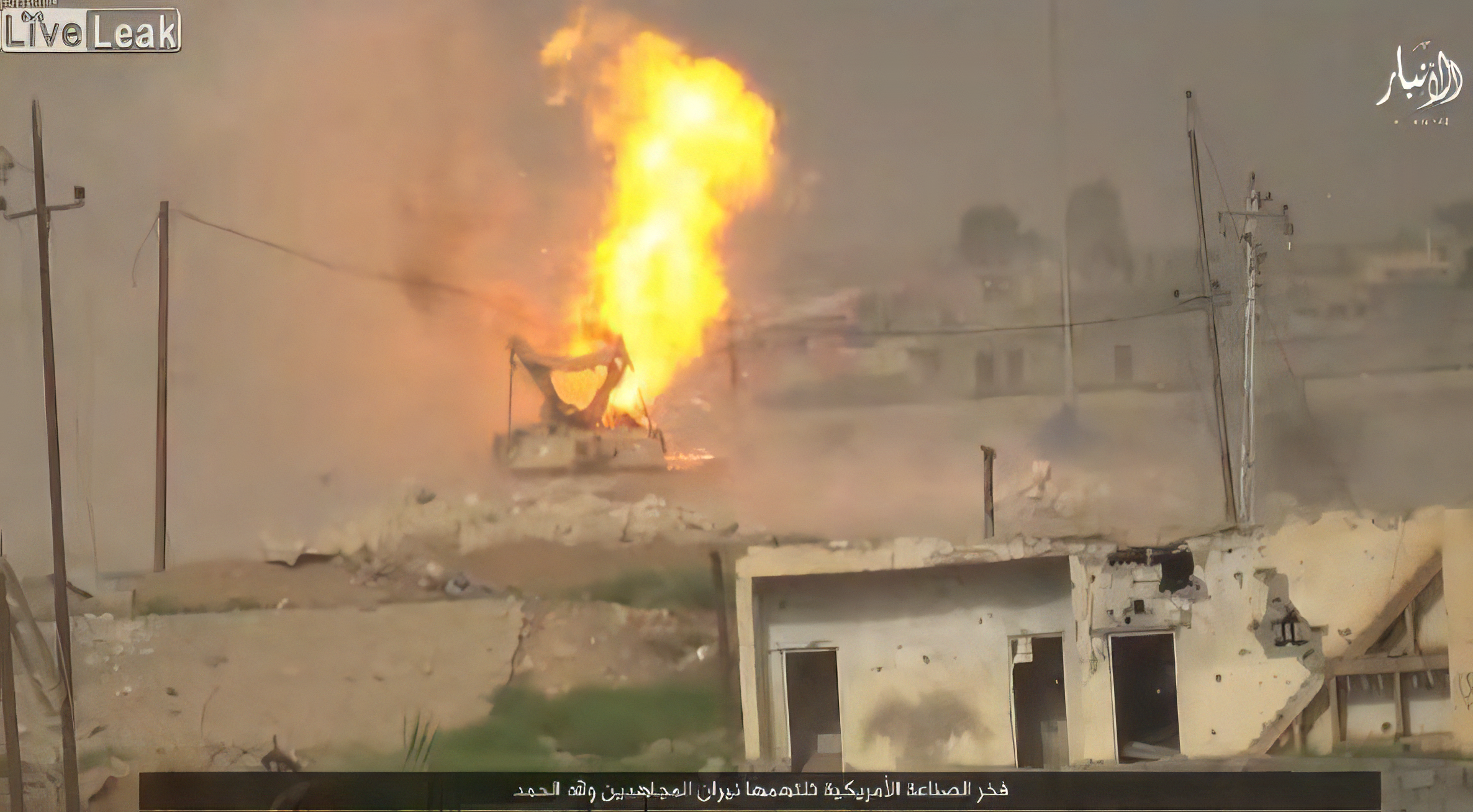
Credit: Islamic State video, via LiveLeak
Assessment
The 2015 and 2016 offensives of the Gulf Coalition were largely successful in driving Houthi forces out of Aden and preventing an immediate collapse of the Yemeni government and anti-Houthi resistance. The initial mission for which the armoured vehicles were deployed was therefore successfully achieved, even if the remainder of the campaign is seen to have failed.
In circumstances where the Coalition forces were vulnerable – stationary guard posts on the Saudi-Yemen border for instance – the Houthis were able to exploit this with successful engagements using ATGMs. This tends to be disregarded as a tactical as opposed to technical shortcoming, however it is worth noting that survivability of Israeli vehicles in stationary positions was improved with the addition of Trophy. UAE vehicles are ostensibly more survivable based on loss counts, but it is impossible to assess whether they were engaged in as heavy fighting as the Saudi forces. Finally, it is abundantly clear that a non-state aggressor is capable of delaying and degrading modern armour. The use of the AM-50 against the sights of the Leclerc and external fittings was unlikely to turn the war in the Houthis favour, but it would have degraded vehicle availability and combat readiness.
It seems that in many cases, Saudi armour was acting alone – either without supporting infantry – or without the wrap-around capabilities of combined arms. There are many accounts of isolated Saudi outposts and armoured columns being destroyed or overrun by well-organised Houthi attacks. However, in cases where Saudi forces were supported by Apaches or close air support, the Houthis usually lost the engagement. This reinforces the assessments from the two previous case studies.
Conclusion
From the fields of Ukraine to the cities of Gaza and Iraq, or the deserts and cities of Yemen, this report has examined (briefly) the performance of the best-protected armoured vehicles in the world. It shows that losses are common and should be expected when adversaries are capable of deploying advanced anti-armour weapons such as the Kornet or Yasin-105. It indicates that armour can be survivable and lethal if properly protected by layered matrices including an APS and reactive armour. However, it also reveals the limits of modern armour.
In the cases where combined arms tactics have not been used or platforms have been deployed in isolated packets without supporting fires, attrition is high. This is a recurring theme and cannot be dismissed. This hypothesis is not new, nor is it exciting. However, it should form a central pillar of every discussion around armoured warfare. The excited reporting ahead of Ukraine’s counter-offensive was rarely tempered with a sober discussion of the need for combined arms and overwhelming firepower when approaching prepared defences. The Israeli offensive into Gaza was overshadowed by propaganda, with many assuming the IDF would suffer unacceptable losses because of a failure to account for the effects of armour coordinated with massed fires and close air support. Iraq’s losses in Mosul showed the risks of engaging a well-prepared and driven opponent using heavy armour without infantry, and the Saudi losses on the border with Yemen demonstrate that static armour does not make for a deterrent if it is not supported by sensors and systems that enable it to shoot before an opponent.
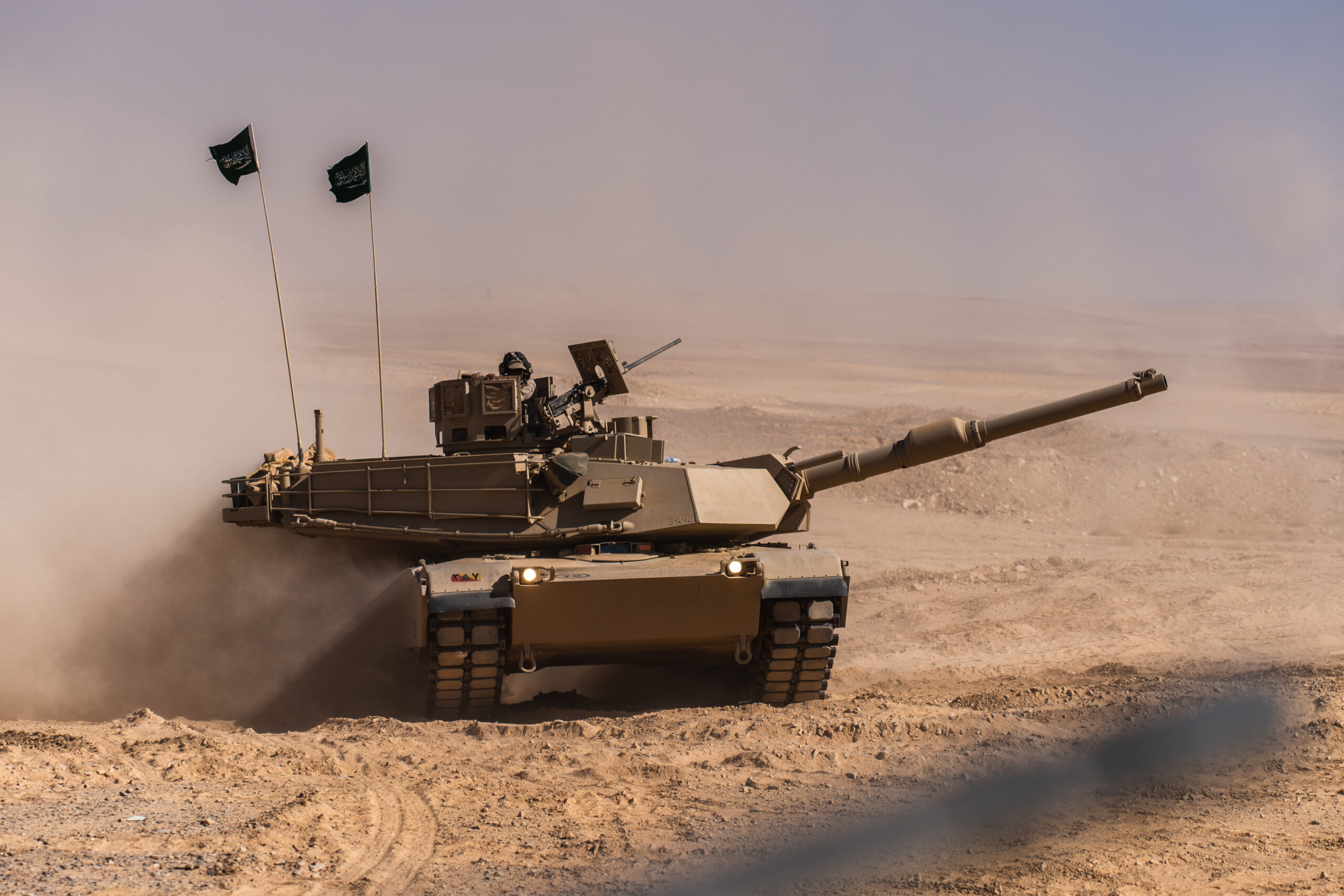
Credit: US Army/Sgt Anthony Prater
At a technical level, it is worth returning to the statement made at the outset of this report. Many of these vehicles have been modified to meet existing threats rather than built to counter them. This means that in some cases, they are perhaps facing modern threats at a disadvantage. For instance, how much more survivable would a T-72B3 be if it could redistribute its frontal armour to its sides or relocate its autoloader into a turret bustle? ATGMs are clearly problematic, however ERA and an APS offer a solution that is challenging for them to negate. Small drones are everywhere and can have dramatic effects if deployed en masse, however they have been covered only briefly here. The reason for this, is that beyond deploying grenades into the open hatches of vehicles that might already be disabled, FPV drones face a lethality problem; until they can deploy larger warheads, it will be difficult for them to make a real impact against heavy armour. Their effects are far more pronounced in correcting artillery fire or targeting the unprotected aspects of a force.
Overall, this study indicates that armour requires a matrix of elements to have an effect against modern threats. At the inner levels, advanced composite and reactive armour combined with an APS is fast becoming essential. Beyond this, good sensors and battle management is key to coordinating efforts and sharing data between platforms. However, all of this will come to little if it is not part of a combined arms formation operating with full supporting firepower from the land, sea, and air. This conclusion should be clear to most, however, it is an important one to re-emphasise in an attempt to move capability discussions away from a comparison of gun size and armour thickness, to one of combined arms effectiveness.
Sam Cranny-Evans
[1] https://id3486.securedata.net/fprado/armorsite/Merkava-Files/Merkava04.pdf
[2] https://hal.science/hal-02613321/document
[3] https://csis.org/analysis/seizing-initiative-ukraine-waging-war-defense-dominant-world
[4] https://tass.com/defense/1647379
[5] https://lostarmour.info/armour
[6]https://journals.lww.com/journalacs/fulltext/2023/08000/putting_medical_boots_on_the_ground__lessons_from.31.aspx
[7] https://static.rusi.org/Stormbreak-Special-Report-web-final_0.pdf
[8] https://armyhistory.org/the-gulf-war-and-european-artillery/
[9] https://www.ft.com/content/5093220b-e615-4cd0-872e-87c638bce7e4
[10] https://storymaps.arcgis.com/stories/2e746151991643e39e64780f0674f7dd
[11] https://www.ft.com/content/8cd7120e-42d5-47f0-a6fe-e997d9375701
[12] https://www.telegraph.co.uk/world-news/2023/11/16/hamas-fighters-hiding-gaza-israel-war-where-terrorists/
[13] https://web.archive.org/web/20090117184057/http://www.terrorism-info.org.il/malam_multimedia/English/eng_n/pdf/hamas_080408.pdf
[14] https://twitter.com/IrnaEnglish/status/1722302246094885363
[15] https://cat-uxo.com/explosive-hazards/rockets/105mm-pg-7r-rocket
[16] https://english.iswnews.com/31801/military-knowledge-al-yassin-105-anti-tank-rocket-the-zionists-nightmare-in-gaza/
[17] https://www.terrorism-info.org.il/en/hamass-use-of-anti-tank-kornet-missiles-supplied-by-iran-and-hezbollah/
[18] https://web.archive.org/web/20090117184057/http://www.terrorism-info.org.il/malam_multimedia/English/eng_n/pdf/hamas_080408.pdf
[19] https://twitter.com/IranDefense/status/1720860893863350401
[20] https://www.theguardian.com/world/2023/nov/04/as-their-soldiers-fight-hand-to-hand-in-gaza-israelis-wonder-about-the-endgame
[21] https://www.janes.com/defence-news/news-detail/iav-2021-rafael-offers-new-armour-shield-ke-reactive-armour-tailored-to-apfsds-threat
[22] https://www.janes.com/defence-news/news-detail/idf-orders-fire-weaver-network-fire-control-system
[23] https://mwi.westpoint.edu/the-israeli-way-of-urban-warfare/
[24] https://www.i24news.tv/en/news/israel-at-war/1700567942-idf-reports-first-use-of-iron-sting-system-in-combat
[25] https://www.instagram.com/p/Czl69EpL-an/
[26] https://tinyurl.com/mrypba96
[27] https://tinyurl.com/4da7abj3
[28] https://www.israeldefense.co.il/en/node/60200
[29] https://tinyurl.com/mrypba96
[30] https://www.timesofisrael.com/several-idf-deaths-in-gaza-ground-offensive-were-the-result-of-friendly-fire/
[31] https://www.idf.il/en/mini-sites/hamas-israel-war-23/all-articles/eliminated-key-hamas-terrorist-operatives-eliminated-by-the-idf-and-isa/
[32] https://www.washingtoninstitute.org/policy-analysis/saudi-uae-war-effort-yemen-part-1-operation-golden-arrow-aden
[33] https://www.calibreobscura.com/the-iranian-50-cal-am-50-sayyad/
[34] https://medium.com/@project.masam/clearing-homemade-and-sophisticated-ieds-in-yemen-to-keep-civilians-safe-b65817fd91c7
[35] https://twitter.com/JoshuaKoontz__/status/1679588166234144770
[36] https://wavellroom.com/podcast/tmw-yemen-micheal-knights/
[37] https://www.scoop.co.nz/stories/WL0912/S01637/cablegate-who-are-the-houthis-part-two-how-are-they.htm
[38] https://usnews.com/news/world/articles/2017-03-21/exclusive-iran-steps-up-support-for-houthis-in-yemens-war-sources
[39] https://www.jstor.org/stable/10.7249/mg962dia.17
[40] https://www.washingtoninstitute.org/policy-analysis/gulf-coalition-operations-yemen-part-1-ground-war
[41] Janes Armoured Fighting Vehicles; Tracked, 2021/2022.
[42] https://www.lopinion.fr/secret-defense/70-chars-leclerc-emiratis-engages-au-yemen and https://www.forcesoperations.com/amp/le-conflit-yemenite-bapteme-du-feu-pour-les-leclerc-emiratis/
[43] https://defense-arab.com/vb/threads/112401/
[44] https://youtu.be/uBAeYzp7vTE
[45] https://defense-arab.com/vb/threads/112401/
[46] https://www.bellingcat.com/news/mena/2019/04/11/logbook-part-i-the-uaes-bmp-3-ifv-in-yemen/
[47] https://www.aei.org/wp-content/uploads/2020/10/Sizing-up-Little-Sparta-Understanding-UAE-military-effectiveness-3.pdf
[48] https://twitter.com/Mikeknightsiraq/status/1720039090815463517
[49] https://twitter.com/TheDeadDistrict/status/1314443771321384960
[50] https://lostarmour.info/yemen
[51] https://lostarmour.info/yemen
[52] https://www.dailymotion.com/video/x47qnr5
[53] https://www.independent.co.uk/voices/yemen-war-rapidly-becoming-as-messy-and-complicated-as-the-conflict-in-syria-a6937026.html and https://www.thenationalnews.com/uae/uae-rulers-celebrate-armed-forces-efforts-in-yemen-1.976400
[54] https://www.longwarjournal.org/archives/2014/07/islamic_state_routs.php; https://www.longwarjournal.org/archives/2015/02/islamic_state_releases_compila.php
[55] https://mwi.westpoint.edu/urban-warfare-project-case-study-2-battle-of-mosul/
[56] https://www.dailymail.co.uk/news/article-3898918/Video-shows-Russian-missile-fired-ISIS-completely-obliterate-tank-Iraq-showing-vulnerable-American-armored-vehicles-battlefield.html



